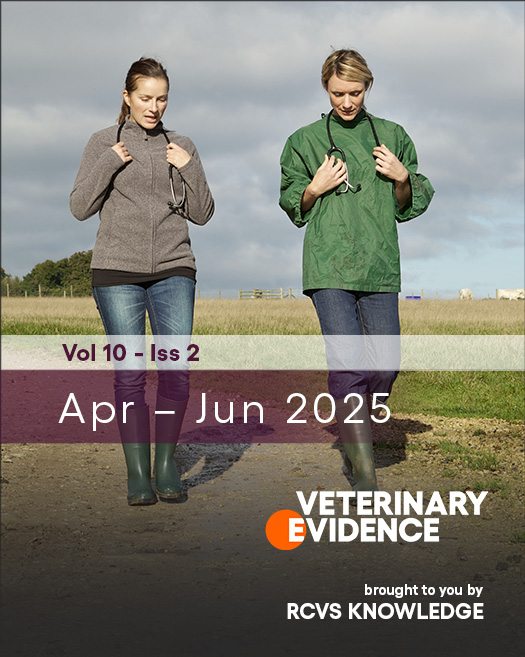DOI
https://doi.org/10.18849/ve.v10i2.708Abstract
Question
In healthy adult female non-pregnant sheep undergoing general anaesthesia for research studies does the inclusion of intravenous medetomidine as part of the anaesthetic protocol cause hypoxaemia?
Clinical bottom line
The category of research question was:
Treatment.
The number and type of study designs that were critically appraised were:
Four papers were available for critical appraisal. The quality of the evidence is weak. There were four experimental studies; three of which were cross-over studies and one study which was run in parallel with primary orthopaedic research. None of the studies were specifically focussed on the potential hypoxaemic effects of medetomidine.
Critical appraisal of the selected papers meeting the inclusion criteria collectively provide zero/weak/moderate/strong evidence in terms of their experimental design and implementation:
Weak.
The outcomes reported are summarised as follows…
Sheep across all four studies developed hypoxaemia (indicated by arterial oxygen tension; either PaO2 < 80 mmHg/10 kPa when breathing room air, or a statistically significant fall in PaO2 compared with baseline, when breathing oxygen enriched gases), when medetomidine was administered intravenously and in combination with various drugs (i.e. midazolam, propofol, ketamine, halothane, and isoflurane). However, as the sheep were receiving various doses of medetomidine at various timepoints, different quantities of supplemental oxygen (if any), varying ventilatory management (two studies used mechanical ventilation and two studies allowed sheep to breathe spontaneously), and different agents were used to maintain anaesthesia, the clinical significance of the PaO2 values was difficult to assess.
In view of the strength of evidence and the outcomes from the studies the following conclusion is made…
In clinically healthy (judged by clinical examination) adult female non-pregnant sheep undergoing general anaesthesia (characterised by placement of an endotracheal tube and/or the use of anaesthetic induction agents i.e. barbiturates, ketamine, propofol), the weak evidence presented here suggests that use of intravenous medetomidine can be expected to cause hypoxaemia. However, hypoxaemia is variable and its clinical effects can be lessened with anaesthetic techniques such as the provision of supplemental oxygen.
References
Banstola, A. & Reynolds, J.N.J. (2022). The Sheep as a Large Animal Model for the Investigation and Treatment of Human Disorders. Biology. 11(9), 1251. DOI: https://doi.org/10.3390/biology11091251
Caulkett, N.A., Cribb, P.H. & Duke, T. (1994). Cardiopulmonary effects of medetomidine-ketamine immobilization with atipamezole reversal and carfentanil-xylazine immobilization with naltrexone reversal - A comparative study in domestic sheep (Ovis-Ovis). Journal of Zoo and Wildlife Medicine. 25(3), 376–389.
Celly, C.S., McDonell, W.N., Young, S.S. & Black, W.D. (1997). The comparative hypoxaemic effect of four alpha 2 adrenoceptor agonists (xylazine, romifidine, detomidine and medetomidine) in sheep. Journal of Veterinary Pharmacology and Therapeutics. 20(6), 464–471. DOI: https://doi.org/10.1046/j.1365-2885.1997.00097.x
Celly, C.S., McDonell, W.N. & Black, W.D. (1999a). Cardiopulmonary Effects of the α2-Adrenoceptor Agonists Medetomidine and ST-91 in Anesthetized Sheep. Journal of Pharmacology and Experimental Therapeutics. 289(2), 712–720. DOI: https://doi.org/10.1016/S0022-3565(24)38192-3
Celly, C.S., Atwal, O.S., McDonell, W.N. & Black, W. D. (1999b). Histopathologic alterations induced in the lungs of sheep by use of alpha2-adrenergic receptor agonists. American Journal of Veterinary Research. 60(2), 154–161.
Dugdale, A.H.A., Beaumont, G., Bradbrook C. & Gurney M. (2020). Veterinary Anaesthesia: Principles to Practice. Hoboken, New Jersey: Wiley-Blackwell.
Lindeque, B., Schoeman, H., Dommisse, G., Boeyens, M. & Vlok, A. (1987). Fat embolism and the fat embolism syndrome. A double-blind therapeutic study. The Journal of Bone & Joint Surgery British Volume. 69-B(1), 128–131. DOI: https://doi.org/10.1302/0301-620X.69B1.3818718
Lizarraga, I. & Chambers, J.P. (2012). Use of analgesic drugs for pain management in sheep. New Zealand Veterinary Journal. 60(2), 87–94. DOI: https://doi.org/10.1080/00480169.2011.642772
Kästner, S.B.R. (2006). A(2)-agonists in sheep: a review. Veterinary Anaesthesia and Analgesia. 33(2), 79–96. DOI: https://doi.org/10.1111/j.1467-2995.2005.00243.x
Kästner, S.B.R., Von Rechenberg, B., Keller, K. & Bettschart-Wolfensberger, R. (2001) Comparison of Medetomidine and Dexmedetomidine as Premedication in Isoflurane Anaesthesia for Orthopaedic Surgery in Domestic Sheep. Journal of Veterinary Medicine Series A. 48(4), 231–241. DOI: https://doi.org/10.1046/j.1439-0442.2001.00354.x
Raekallio, M., Tulamo, R.M. & Valtamo, T. (1998). Medetomidine-Midazolam Sedation in Sheep', Acta Veterinaria Scandinavica. 39(1), 127–134. DOI: https://doi.org/10.1186/bf03547814
Raisis, A.L., Hosgood, G.L., Crawford, N., Kästner, S., Musk, G.C., Herrmann, P. & Mosing, M. (2021). Comparison of pulmonary function in isoflurane anaesthetized ventilated sheep (Ovis aries) following administration of intravenous xylazine versus medetomidine. Laboratory Animals. 55(5), 443–452. DOI: https://doi.org/10.1177/0023677220983366
License
Copyright (c) 2025 Rachael Gregson

This work is licensed under a Creative Commons Attribution 4.0 International License.
Veterinary Evidence uses the Creative Commons copyright Creative Commons Attribution 4.0 International License. That means users are free to copy and redistribute the material in any medium or format. Remix, transform, and build upon the material for any purpose, even commercially - with the appropriate citation.
